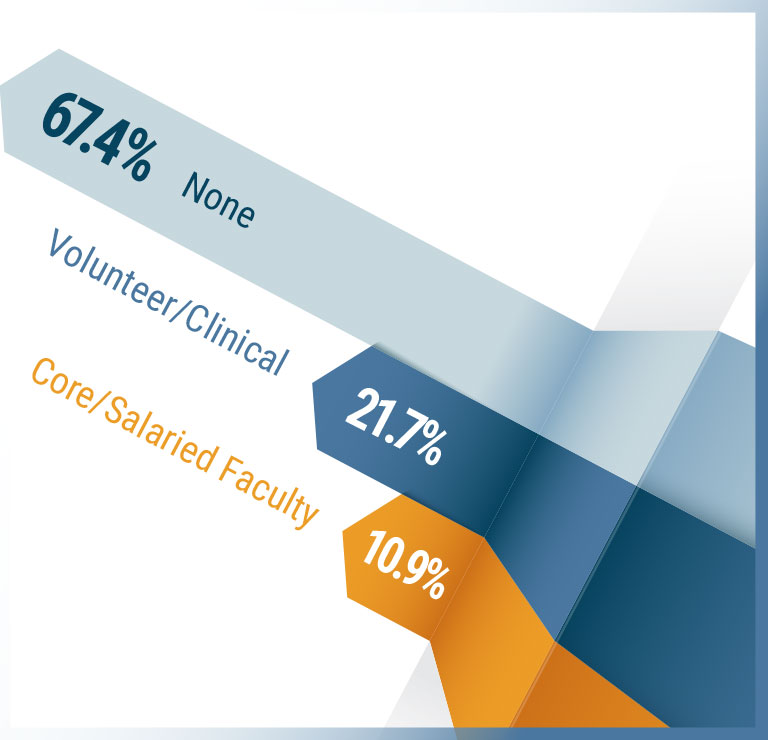On this page
6. What Do Family Physicians Do?
Additional Board Certification
The American Board of Family Medicine (ABFM) is one of 24 medical specialty boards that make up the American Board of Medical Specialties (ABMS), through which specialty boards work to establish standards to maintain physician certification.27 These standards are specific to each specialty and subspecialty to represent individual knowledge and skills in particular areas of medicine.28 Requirements for ABFM certification include participation in ongoing knowledge assessments, continuing medical education requirements, demonstrating improving care in their practices, complying with professional and licensure standards, and passing examinations every ten years.29 The American Osteopathic Association (AOA) is a certification organization for osteopathic physicians and includes the American Osteopathic Board of Family Physicians (AOBFP). AOBFP has its own certification process, which almost 30,000 family physicians have completed.31 Board certification is voluntary, and family physicians can elect to certify with either ABFM or AOBFP, both organizations, or neither. Outside of the United States, other countries have their own physician certification boards such as The College of Family Physicians of Canada which represents over 42,000 physicians across Canada.32
Seven and a half percent (7.5%) of ABFM Diplomates report that they are certified by other board organizations. Of note, the plurality of those earlier in their career who reported additional board certification had certification with AOBFP (44.8%). This was much higher than the mid-or late career Diplomate cohort, where only 9% reported AOBFP certification. This group reported unlisted boards designated as “Other” on the questionnaire the most (62.1%).
7.5%
ARE CERTIFIED IN
ANOTHER SPECIALITY BOARD
FIGURE 17. ABFM Family Physicians with Additional Board Certification
Added Qualifications
The ABFM offers Certificates of Added Qualifications and a Designation of Focused Practice to support family physicians who have an area of focused expertise after additional training.33 These certificates are valid for ten years and can be renewed as part of the Diplomate continuous certification process.34 The most common certificates held by ABFM Diplomates are in Sports Medicine and Geriatric Medicine.
TABLE 10. Family Physicians with Certificates of Added Qualifications (CAQ) or Designation of Focused Practice (DFP)
Practice Scope
Family physicians’ training incorporates care for children, adults, and the elderly in outpatient and inpatient settings as well as patients throughout pregnancy, birth, and the postpartum period. Family medicine trainees must also receive training in behavioral health issues, chronic disease management, population health, and health system management–while emphasizing wellness and disease prevention.35 This broad training results in variations in actual clinical practice with further heterogeneity across region and physician characteristics such as age cohort and sex.36
Given the large number of family physicians throughout the U.S., trend analysis is difficult but ABFM’s data can serve as a major contributor towards a greater understanding of the actual practice scope of family physicians.36 Family medicine residents and ABFM Diplomates were surveyed about their practice of hospital-based medicine, maternity care, outpatient services such as behavioral health and integrative health, chronic medical conditions including diabetes, hypertension, HIV or hepatitis C infection and substance use disorder, and end of life care. Respondents also provided information about common procedures they perform, including gynecological care, musculoskeletal conditions, inpatient acute management, and office-based procedures. In comparing our surveyed cohorts, while family medicine residents intend to have a wide scope of practice and procedure performance, actual clinical practice decreases with time (see changes from early career Diplomates compared to mid-or late career Diplomates).
TABLE 11. Reported Practice Intention of Family Medicine Residents and Practice Scope of Family Physicians
FIGURE 18. Comparing Practice Intention of Family Medicine Residents with Practice Scope of Family Physicians
TABLE 12: Reported Procedure Intention of Family Medicine Residents and Procedure Scope of Family Physicians
FIGURE 19: Comparing Procedure Intention of Family Medicine Residents with Procedure Scope of Family Physicians
Academic Family Physicians
Formal family medicine education involves graduation from an accredited medical school, formal family medicine residency completion (3-4 years), and optional fellowship(s) if a candidate elects to do additional training or sub-specialization. Family physicians can subsequently participate as educators through roles in medical school curriculum teaching, clinical precepting of trainees, and residency/fellowship programming and development. About 1 in 3 ABFM Diplomates report having a faculty role of some form and, of this faculty group, 1 in 3 serve as core or salaried faculty.
FIGURE 20. Family Physicians by Faculty Role

